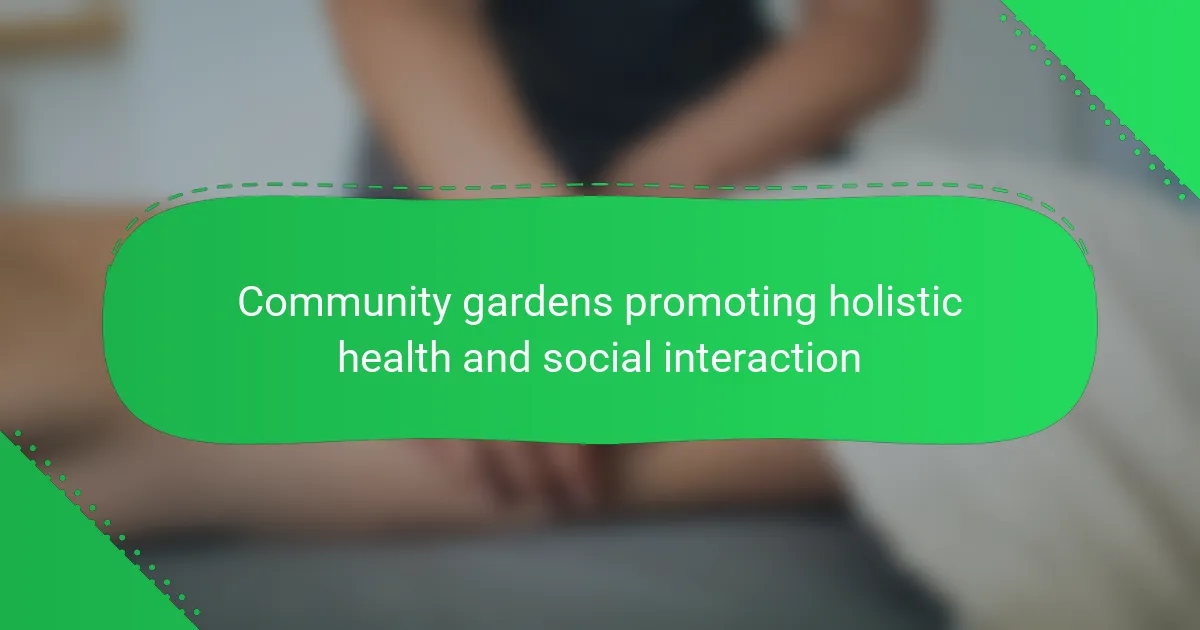Community gardens significantly enhance holistic health by promoting physical activity, social interaction, and mental well-being. They provide accessible green spaces for gardening, encourage sustainable practices, and foster community engagement through workshops and events. Despite facing challenges like limited land access and varying climate conditions, these gardens thrive by embracing cultural diversity and innovative approaches. Numerous organizations support these initiatives, empowering communities to create sustainable environments that benefit both health and social cohesion.

How do community gardens enhance holistic health?
Community gardens enhance holistic health by promoting physical activity, social interaction, and mental well-being. They provide a space for individuals to engage in gardening, which encourages exercise and access to fresh produce. Research shows that participation in community gardens can reduce stress and improve mood by fostering a sense of belonging and community connection. Additionally, these gardens often serve as educational platforms, teaching sustainable practices and healthy eating habits, further contributing to overall health.
What physical health benefits do community gardens provide?
Community gardens provide numerous physical health benefits, including improved nutrition and increased physical activity. These gardens promote access to fresh produce, encouraging healthier eating habits. Engaging in gardening activities also enhances physical fitness through manual labor and outdoor exercise. Additionally, community gardens foster social interaction, which can lead to reduced stress and improved mental well-being. Studies indicate that participants in community gardening report higher levels of physical activity compared to non-participants.
How do community gardens promote mental well-being?
Community gardens significantly enhance mental well-being by fostering social connections and providing therapeutic interactions with nature. They create a sense of belonging, reduce feelings of isolation, and promote stress relief through gardening activities. Engaging in community gardening can lower anxiety levels and improve overall mood, contributing to holistic health. Studies show that spending time in green spaces can increase happiness and life satisfaction, making community gardens essential for mental health support.
Which social connections are fostered through community gardening?
Community gardening fosters various social connections, enhancing community bonds and promoting holistic health. Participants often engage in teamwork, share gardening tips, and develop friendships. These interactions can lead to increased social support, improved mental well-being, and a sense of belonging. Additionally, community gardens serve as spaces for cultural exchange, where diverse groups collaborate and learn from each other. This unique environment nurtures relationships that extend beyond gardening, fostering a resilient community network.
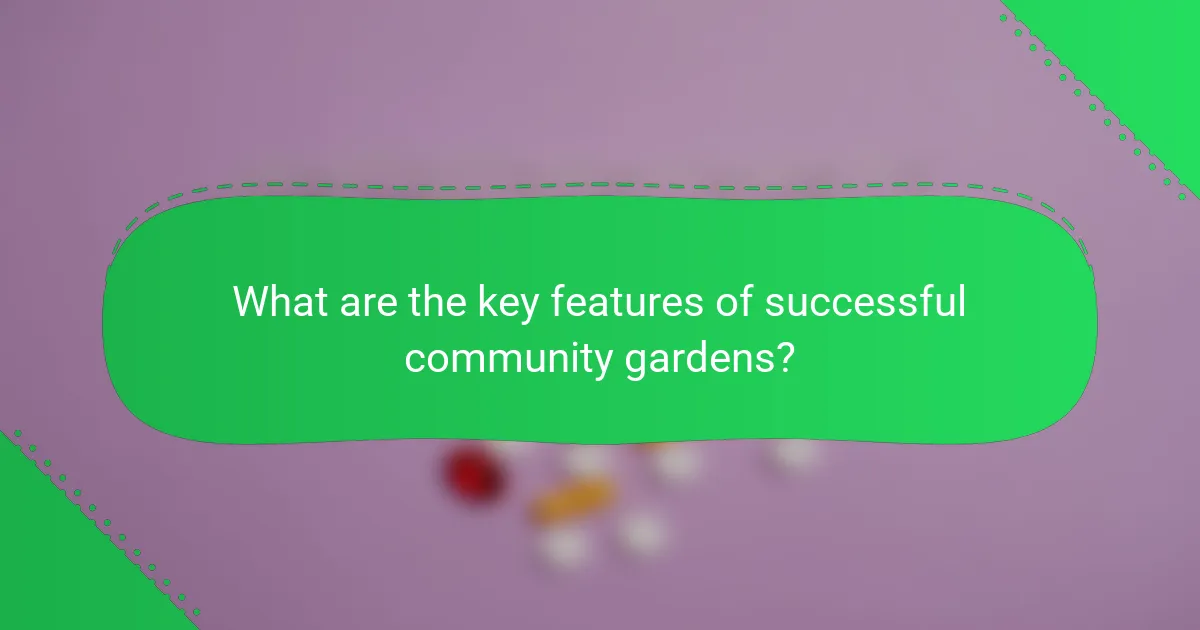
What are the key features of successful community gardens?
Successful community gardens enhance holistic health and foster social interaction through key features. They promote biodiversity by cultivating various plants, which improves local ecosystems. They provide accessible green spaces, encouraging physical activity and mental well-being. Community engagement is vital; these gardens often host workshops and events, strengthening social ties. Additionally, they facilitate knowledge sharing about sustainable practices, enhancing community resilience.
How does garden design influence community interaction?
Community gardens enhance social interaction and holistic health by providing shared spaces for collaboration and communication. These gardens foster relationships among participants, creating a sense of belonging.
Research shows that community gardens can reduce stress and improve mental well-being, contributing to overall health benefits. Participants engage in physical activity, leading to better fitness levels.
Additionally, these gardens often serve as educational platforms, teaching sustainable practices and nutrition. They encourage diverse community involvement, bridging cultural gaps and promoting inclusivity.
As a result, community gardens act as vital hubs for social cohesion, nurturing connections that enhance community resilience and support systems.
What role do volunteers play in community gardens?
Volunteers play a crucial role in community gardens by fostering holistic health and enhancing social interaction. They contribute to garden maintenance, promote sustainable practices, and create a sense of belonging. Volunteers often share knowledge about gardening, nutrition, and environmental stewardship, which enriches community ties. Additionally, their involvement can lead to improved mental and physical health outcomes through regular outdoor activity and social engagement. Overall, volunteers help transform community gardens into vibrant spaces that support both individual well-being and collective harmony.
Which plants are most commonly grown in community gardens?
Common plants grown in community gardens include tomatoes, peppers, lettuce, herbs, radishes, and cucumbers. These plants promote holistic health by providing fresh produce and fostering social interaction among gardeners. Tomatoes are favored for their versatility and yield, while herbs like basil and parsley enhance culinary experiences. Lettuce and radishes grow quickly, offering fast rewards for community members. Cucumber plants thrive in shared spaces, encouraging collaboration and shared gardening practices.

What challenges do community gardens face in different regions?
Community gardens face various challenges depending on their regions. These include limited access to land, varying climate conditions, and differing community engagement levels. Urban areas often struggle with space constraints, while rural gardens may deal with agricultural regulations. Additionally, funding and resource availability can vary significantly across regions, impacting sustainability efforts. Social dynamics also play a role; some communities may lack the collaboration needed for successful garden initiatives. Addressing these challenges requires tailored strategies that consider local conditions and community needs.
How do climate conditions affect community gardening?
Climate conditions significantly influence community gardening by affecting plant growth, soil health, and social engagement. Favorable weather promotes diverse crops, enhancing nutritional benefits and community interaction. Conversely, extreme temperatures or unpredictable weather can hinder gardening efforts, impacting mental well-being and social cohesion. Communities often adapt by selecting resilient plant varieties, fostering a sense of resilience and shared purpose.
What are common funding sources for community gardens?
Common funding sources for community gardens include grants, local government support, private donations, crowdfunding, and partnerships with non-profits. Grants from organizations like the USDA or local foundations provide financial assistance. Local governments often allocate funds for community development. Private donations from individuals or businesses can also support garden initiatives. Crowdfunding platforms enable community members to contribute directly. Collaborations with non-profits can bring in resources and expertise, enhancing the garden’s impact on holistic health and social interaction.
Which regulatory issues impact community gardens?
Regulatory issues significantly impact community gardens by influencing land use, zoning laws, and health regulations. Local governments often enforce strict zoning regulations that can limit where community gardens can be established. Additionally, health codes may require gardens to adhere to specific sanitation standards, which can complicate operations. Community gardens may also face challenges related to property rights, access to water, and liability insurance. These factors can hinder their potential to promote holistic health and social interaction within communities.
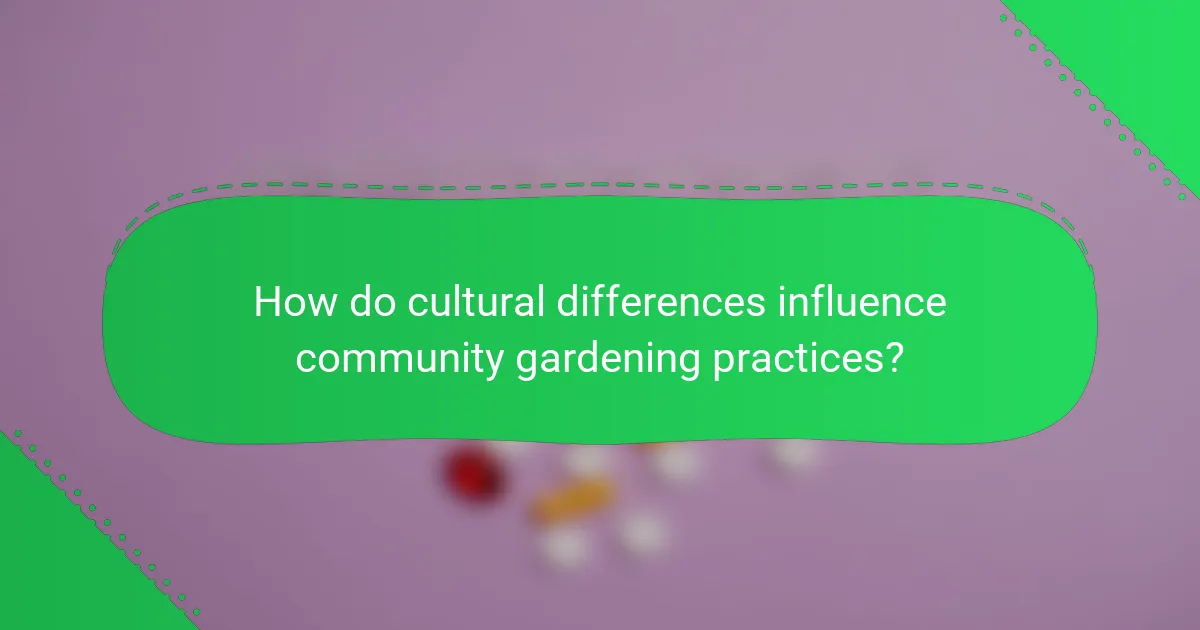
How do cultural differences influence community gardening practices?
Cultural differences significantly shape community gardening practices by influencing participation, design, and resource sharing. Diverse cultural backgrounds bring unique gardening techniques and plant preferences, enriching the community’s biodiversity. For example, some cultures prioritize native plants, while others focus on vegetables. This variety fosters social interaction and learning among participants. Additionally, cultural norms impact how community gardens are organized and maintained, affecting volunteer engagement and sustainability. Overall, these differences enhance the holistic health benefits and social cohesion that community gardens offer.
What unique gardening techniques are used in different cultures?
Community gardens in various cultures utilize unique techniques that enhance holistic health and foster social interaction. Techniques include companion planting, crop rotation, and permaculture principles.
In Japan, the practice of forest bathing incorporates gardening to promote mental well-being. In Cuba, urban agriculture focuses on sustainability and community resilience, emphasizing food security.
Hmong communities in Southeast Asia employ vertical gardening to maximize space and yield. Indigenous peoples in North America practice the Three Sisters method, cultivating corn, beans, and squash together for mutual benefit.
These diverse methods not only improve health outcomes but also strengthen community bonds through shared gardening experiences.
How do community gardens reflect local traditions and values?
Community gardens reflect local traditions and values by fostering community engagement and promoting cultural practices. They serve as spaces for shared experiences, where people cultivate not only plants but also relationships. These gardens often incorporate native plants and traditional farming techniques, emphasizing the importance of local heritage. As a result, they become living expressions of community identity, showcasing diverse cultural backgrounds and encouraging sustainable practices.
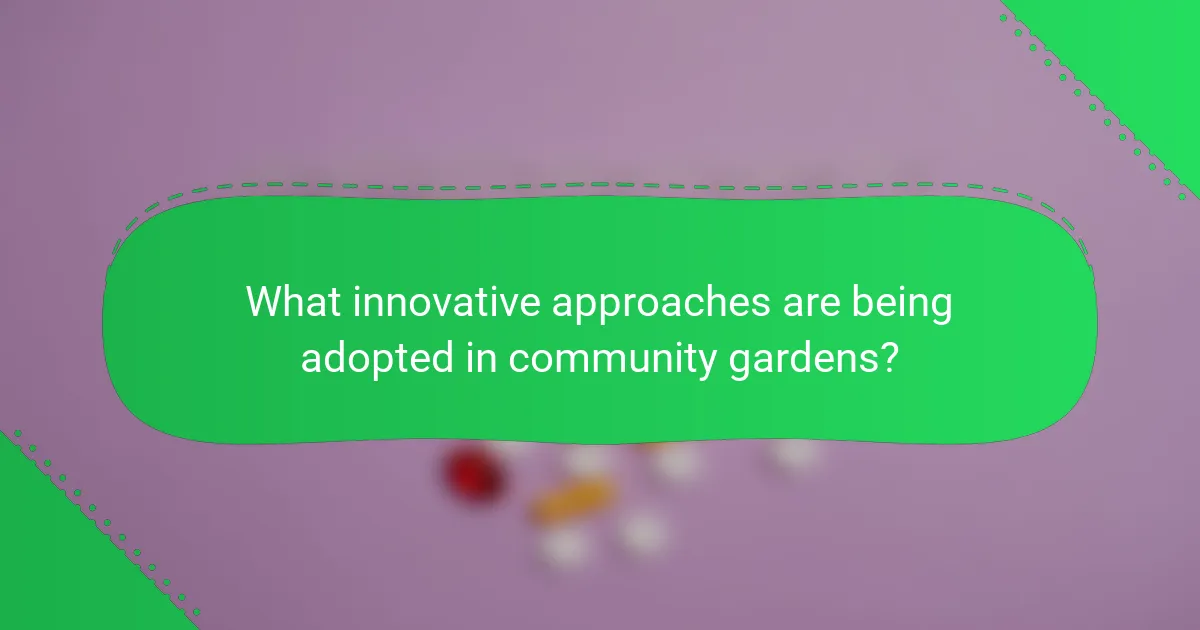
What innovative approaches are being adopted in community gardens?
Community gardens are adopting innovative approaches that enhance holistic health and foster social interaction. These gardens utilize permaculture principles to promote biodiversity and sustainable practices. They often incorporate educational workshops, which empower community members with gardening skills and nutritional knowledge. Additionally, many gardens are integrating technology, such as mobile apps, to connect gardeners and share resources efficiently. Collaborative events, like harvest festivals, strengthen community bonds and celebrate local produce. These strategies not only improve physical health but also enhance mental well-being through social engagement.
How are digital tools enhancing community gardening efforts?
Digital tools significantly enhance community gardening by facilitating collaboration, resource sharing, and education. These tools enable gardeners to connect, share knowledge, and coordinate activities effectively. For instance, mobile apps allow users to track plant growth, share tips, and organize community events.
Additionally, social media platforms foster social interaction, helping build a sense of community among participants. They provide spaces for sharing successes and challenges, which strengthens relationships. Data analytics can optimize garden layouts and crop selections, improving harvest outcomes.
Moreover, online platforms increase access to resources, such as seeds and gardening supplies, making gardening more inclusive. This enhances community engagement and promotes holistic health by encouraging physical activity and fresh produce consumption.
Overall, digital tools empower community gardens to thrive through enhanced communication, education, and resource accessibility.
What role do educational programs play in community gardens?
Educational programs enhance community gardens by fostering holistic health and promoting social interaction. These initiatives provide knowledge on sustainable practices and nutrition, empowering participants to cultivate healthy habits.
Programs often include workshops on gardening techniques, cooking demonstrations, and health education sessions. As a result, participants gain valuable skills that improve their well-being and strengthen community ties.
Research indicates that community gardens with educational components see increased engagement, leading to better mental and physical health outcomes. For example, individuals involved in these programs report higher levels of satisfaction and social connectivity.
In summary, educational programs in community gardens serve as a catalyst for personal growth, community cohesion, and enhanced quality of life.

Which organizations support community gardens globally?
Numerous organizations support community gardens globally, enhancing holistic health and social interaction. Examples include the American Community Gardening Association, which promotes gardening as a means of improving community health, and the Global Community Gardening Network, which connects gardeners worldwide. Other notable supporters are the National Gardening Association, providing resources for educational programs, and local non-profits that advocate for food justice and urban agriculture initiatives. These organizations foster collaboration and resource sharing, empowering communities to create sustainable gardens.
What resources do these organizations provide to gardeners?
Community gardens provide resources such as educational workshops, access to gardening tools, and social events. These resources foster holistic health and enhance social interaction among participants. Workshops often cover topics like organic gardening, nutrition, and sustainability, promoting a deeper understanding of healthy practices. Access to tools ensures all gardeners can engage effectively, while social events encourage community bonding and collaboration.
How do partnerships enhance the impact of community gardens?
Partnerships significantly enhance the impact of community gardens by fostering collaboration and resource sharing. They connect diverse stakeholders, such as local governments, non-profits, and businesses, which amplifies community engagement and support. As a result, gardens can access funding, expertise, and volunteers, leading to improved sustainability and outreach. Unique partnerships may also introduce educational programs, promoting holistic health and social interaction among participants.
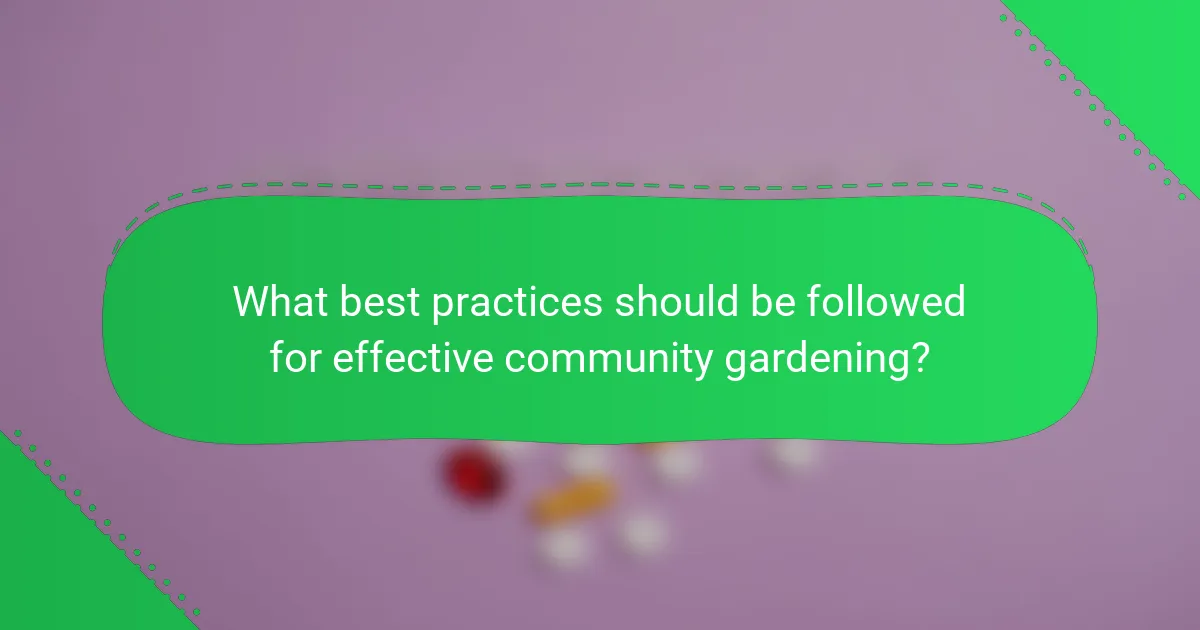
What best practices should be followed for effective community gardening?
Effective community gardening requires collaboration, planning, and education to enhance holistic health and social interaction.
1. Foster community involvement by organizing regular meetings to discuss goals and share responsibilities.
2. Select diverse plant species to promote biodiversity and cater to various dietary needs.
3. Implement sustainable practices, such as composting and organic gardening, to improve soil health and reduce environmental impact.
4. Provide educational resources on gardening techniques and nutrition to empower participants.
5. Create social spaces within the garden to encourage interaction and community bonding.
6. Establish clear guidelines for garden maintenance and conflict resolution to ensure a harmonious environment.
How can community gardens be maintained sustainably?
Community gardens can be maintained sustainably through practices that enhance soil health, conserve water, and promote biodiversity. Implementing composting systems enriches the soil while reducing waste. Rainwater harvesting can efficiently manage irrigation needs. Crop rotation and companion planting foster a balanced ecosystem, minimizing pests and diseases. Engaging the community in maintenance activities strengthens social bonds and collective responsibility. Utilizing native plants supports local wildlife and reduces the need for chemical inputs.
What common mistakes should be avoided in community gardening?
Common mistakes in community gardening include neglecting planning, overlooking soil health, and failing to engage the community. These errors can hinder the garden’s potential to promote holistic health and social interaction.
1. Lack of Planning: Without a clear design and goals, gardens may become chaotic and unproductive.
2. Ignoring Soil Quality: Healthy soil is essential for plant growth; poor soil management leads to low yields.
3. Insufficient Community Involvement: Engaging community members fosters ownership and encourages participation.
4. Overplanting: Crowding plants can lead to competition for resources and reduced overall health.
5. Neglecting Maintenance: Regular upkeep is vital for a thriving garden; neglect can lead to weed overgrowth and pest issues.
6. Not Sharing Knowledge: Failing to educate participants limits the garden’s effectiveness as a learning space.
How can community gardens maximize social interaction and engagement?
Community gardens can significantly enhance social interaction and engagement by fostering a sense of community and shared purpose. They provide a platform for individuals to connect through gardening activities, workshops, and social events.
These gardens create spaces for collaboration, where community members can share knowledge and resources, strengthening relationships. Studies show that participation in community gardens can lead to increased social ties and improved mental well-being.
Additionally, community gardens often host events that encourage participation from diverse groups, creating inclusive environments. This engagement can result in a stronger community identity and collective action toward local issues.
By promoting holistic health through social interaction, community gardens serve as vital hubs for community engagement and personal growth.
